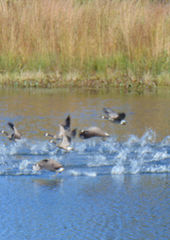Canada Goose
Common Name: Canada Goose.
Scientific Name: Branta Canadensis.
What to look for? Large waterbird. Long black neck with its signature white chinstrap mark. The Canada Goose has a brown body with paler chest and white undertail. They have a wide, flat bill. They have large webbed feet - various website sources indicate black, but the photo to right indicates very blue!
Where can they be found at Carillon Stonegate Pond? You can find Canadian Geese around here off and on throughout the year depending upon temperatures and open water (i.e., not frozen). They may be seen spending some time in our ponds or flying over during seasonal migration. Or sometimes feeding on our well-maintained lawns!
How big are they? The Canada Goose averages around three feet in length. And their wingspan is approximately five feet. They weigh in at around 12 pounds.
What are their flight patterns? Canada Geese fly both night and day. You may see them flying in pairs or flocks. They can cover 1,500 miles in just 24 hours with a favorable wind - and at speeds of up to 70 m.p.h., but typically travel at a much more leisurely rate. Canada Geese migrate in V-formation - northbound in spring, southbound in fall. This is a universally recognized sign of the changing seasons. In this V-formation, experienced individuals take turns leading the flock. And, like the Chicago Bears, Canada Geese overload the right side in this formation!
How else do they behave? Canada Geese feed by “dabbling” in the water - submerging head and neck and sometimes up-ending - or grazing in fields and large lawns. They feed in flocks at most seasons. Canada Goose threat displays may involve head pumping, bill opened with tongue raised, hissing, honking, and vibrating neck feathers. Annually, Canada Geese molt their feathers and are unable to fly for approximately six (6) weeks.
What’s for dinner? Canada Geese are adaptable to many habitats and may thrive wherever grasses, grains, or berries are available. In the spring and summer, Canada Geese concentrate their feeding on grasses and sedges. During fall and winter, they rely more on berries and seeds, including agricultural grains, and seem especially fond of blueberries.
Where do they take up residence? Canada Geese are found in every contiguous U.S. state and Canadian province at one time of the year or another. They live in a great many habitats near water, grassy fields, and grain fields. Canada Geese are particularly drawn to lawns for two reasons: they can digest grass and manicured lawns give them a wide, unobstructed view of any approaching predators as their young feed.
When and where do they breed and nest? Canada Geese mate for life and pairs remain together throughout the year. Geese mate in an assortative manner: larger birds choosing larger mates and smaller ones choosing smaller mates. Most Canada Geese do not breed until their fourth year. They nest on the ground, usually on a muskrat mound or other slightly elevated site, near water. They prefer a spot from which they can have an unobstructed view in many directions. Egg-laying varies considerably, from as early as late March to as late as mid-June. Incubation period is for 28 days, while hatching of all eggs in brood may last up to 24 hours. Precocial goslings are fully covered with yellowish down. They leave nest within 24 hours and are able to walk, swim, feed, and dive. But they will remain in nest over next 6 – 7 weeks until they fledge. The young geese will fly for first time when they are approximately 3 months old.
Where do they migrate? Historically, each local population of Canada Geese followed rigid migratory path, with traditional stopovers and wintering areas. Today many geese in urban areas and on refuges are permanent residents. In winter, Geese can remain in northern areas with some open water and food resources even where temperatures are extremely cold.
What is their conservation status? There is low concern. According to the North American Breeding Bird Survey, the Canada Geese have seen slight increases in populations. Partners in Flight estimates the global breeding population at 5 million.
Do they make any interesting sounds? Canada Geese make various loud honks, barks, and cackles. They also make hisses when being protective. Here is a link to the sounds of the Canada Goose.
Interesting Facts About the Canada Goose:
-
In general, Canada Geese get smaller as you move northward and darker as you go westward.
-
Most Canada Geese make annual northward migrations after breeding. Even members of "resident" populations, which do not migrate southward in winter, will move north in late summer to molt.
-
In a pattern biologists call “assortative mating,” birds of both sexes tend to choose mates of a similar size.
-
The total North American population is estimated to be over 5 million.
For more information on the Canada Goose and sources of information used in this blog (these are the sources that I am using to learn as I blog), please visit All About Birds, Audubon Society and National Geographic. And the Cornell Lab of Ornithology provides a wonderful source of information for anyone interested in learning more about birds.
The Carillon at Stonegate community is very fortunate to have a variety of wetland, forest and prairie environments conducive to a variety of birds and other wildlife, plants and insects. Our community and the Kane County Forest Preserve do an exceptional job in maintaining this natural environment – both for the benefit of the birds and wildlife and for our residents to enjoy.
Take a hike and see what you can find – and identify!
























